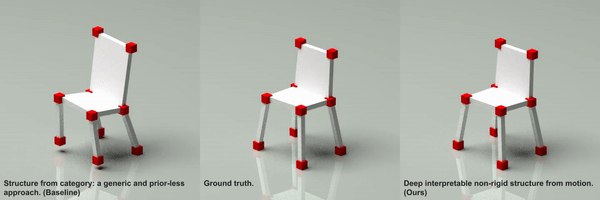Deep Interpretable Non-Rigid Structure from Motion
This repository contains code for the deep interpretable Non-Rigid Structure from Motion (NRSfM) method.
Paper: https://arxiv.org/abs/1902.10840
Prerequisites
We implement our neural network using python3 with these additional packages:
TensorFlowfor NN building, training and evaluation.pandasfor result analysis.plotlyfor quick visualization.
You might want to setup Jupyter Notebook for future visualization.
Guide
Our current release has been tested on Ubuntu 16.04.5 LTS.
To get the code, in terminal, run:
git clone https://github.com/kongchen1992/deep-nrsfm.gitData
We use CMU Graphics Lab Motion Capture Database to train and test our neural network. We create TFRecords for convenience of training and evaluation. You can download the TFRecords file of subject 23 (http://www.cs.cmu.edu/~chenk/deep-nrsfm/23.train) for demo.
Pre-trained models
We offer a pre-trained model for subject 23 for the purpose of demo. You can download it from (http://www.cs.cmu.edu/~chenk/deep-nrsfm/23.tar.gz), unzip and save for demo.
Evaluate pre-trained models
We first change three paths:
path['tfrecords']in filemotion_capture.py: your path to TFRecords.rootin fileevaluate.sh: your path to model checkpoints i.e. the directory of downloaded pre-trained model.outputin fileevaluate.sh: your path to the result directory.
After changing the paths, simply run in terminal:
./evaluate.shThis script will run the provided model with provided TFRecords and save errors
into CSV file and predictions into NPZ file. You should be able to see 23.csv
and 23.npz in your result directory.
Visualize predictions
We offer a Jupyter notebook file for you to quickly check quantitative and qualitative results after evaluation. Start Jupyter by running in terminal:
jupyter notebookand then open the provided Visualization.ipynb in web UI. After properly setting
the path to your evaluations and running the page, you will be able to see the evaluation results and visualizations. An example is demonstrated here (http://www.cs.cmu.edu/~chenk/deep-nrsfm/Visualization.html).
Train a new model
We also offer a script train.sh for you to train a new model. After changing
path['tfrecords']in filemotion_capture.py: your path to TFRecords.rootin filetrain.sh: your path to desired model directory.
You are able to train your own model by simply running in terminal:
./train.shReference
If you use the code, please cite:
@misc{1902.10840,
Author = {Chen Kong and Simon Lucey},
Title = {Deep Interpretable Non-Rigid Structure from Motion},
Year = {2019},
Eprint = {arXiv:1902.10840},
}
For any questions, please contact Chen Kong (chenk@cs.cmu.edu).


